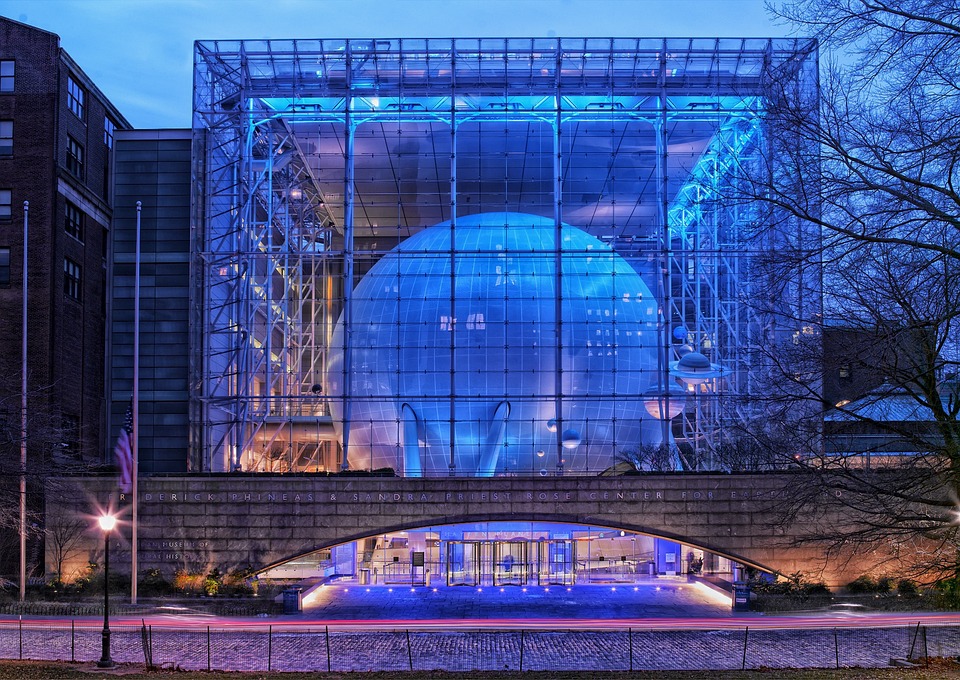The Rose Center for
Earth and Space
Home > New York State Photographs > New York > The Rose Center for Earth and Space

The Rose Center for Earth and Space stood before the photographer, illuminated in a rich violet hue in the clouds of a New York City evening. Its Hayden Sphere, a marvel of modern engineering, seemed to hover in midair seemingly awaiting its next journey to the outer reaches of the galaxy. Around it hung the planets of our solar system, sparkling like stars in the night, inspiring images of the vastness of the cosmos.
The purpose of the Rose Center is to bring illumination to this subject of the Earth and its place in the heavens. It is a source of knowledge, a beacon of light for those who seek to understand the natural, and the supernatural, forces of the universe. From its terraces, one can look out on a panoramic view of the stars and galaxies that stretch out far beyond our own. It serves as a reminder of the beauty of the cosmos and inspires a greater reverence for the infinite beauty of the universe.
Rose Center's other offerings are equally impressive. The Big Bang Theater, occupying the bottom half of the Hayden Sphere, takes viewers on a virtual tour of the dawn of creation, from the Big Bang to the formation of the Solar System. And of course, the Hayden Planetarium, which showcases a detailed look at the planets and stars of our galaxy, offers a unique chance to explore the grandeur of outer space.
Rose Center for Earth and Space
The Rose Center for Earth and Space is a renowned scientific and educational institution located in New York City, USA. It is part of the American Museum of Natural History and is dedicated to the study of Earth, the universe, and the relationship between them. The center's primary goal is to promote scientific literacy and public understanding of our planet and the cosmos.
The Rose Center is named after its major benefactors, Frederick Phineas and Sandra Priest Rose, who made a significant donation to support its construction. It opened to the public in 2000 and quickly gained recognition for its innovative design and immersive exhibits.
One of the center's most iconic features is the Hayden Sphere, also known as the Great Sphere. It is a gigantic sphere clad in perforated aluminum panels that appears to be floating in space within the center. The sphere serves as a visual centerpiece and houses the Star Theater, where visitors can enjoy stunning visual presentations and shows about the universe.
Inside the Rose Center, visitors can explore a wide range of exhibits and displays that cover various aspects of Earth and space science. The exhibits feature interactive displays, multimedia presentations, and authentic artifacts, providing an engaging and educational experience for visitors of all ages.
The Hall of Planet Earth explores the geological processes that have shaped our planet over billions of years. It showcases impressive geological specimens from around the world.
The Cullman Hall of the Universe delves into the vastness of space and the fundamental concepts of astronomy. Visitors can learn about the formation of stars and galaxies and the exploration of our solar system.
The Rose Center also hosts temporary exhibitions that focus on specific topics related to Earth and space science. These exhibitions often feature cutting-edge research, discoveries, and advancements in the field, providing visitors with a glimpse into the latest scientific developments.
In addition to its exhibits, the Rose Center offers a range of educational programs and events. It hosts lectures, workshops, and demonstrations by scientists and experts, aiming to inspire curiosity and a deeper understanding of the natural world.
Overall, the Rose Center for Earth and Space is a world-class institution that combines stunning architecture, immersive exhibits, and educational programs to promote scientific literacy and foster a sense of wonder about the Earth and the universe we inhabit.


